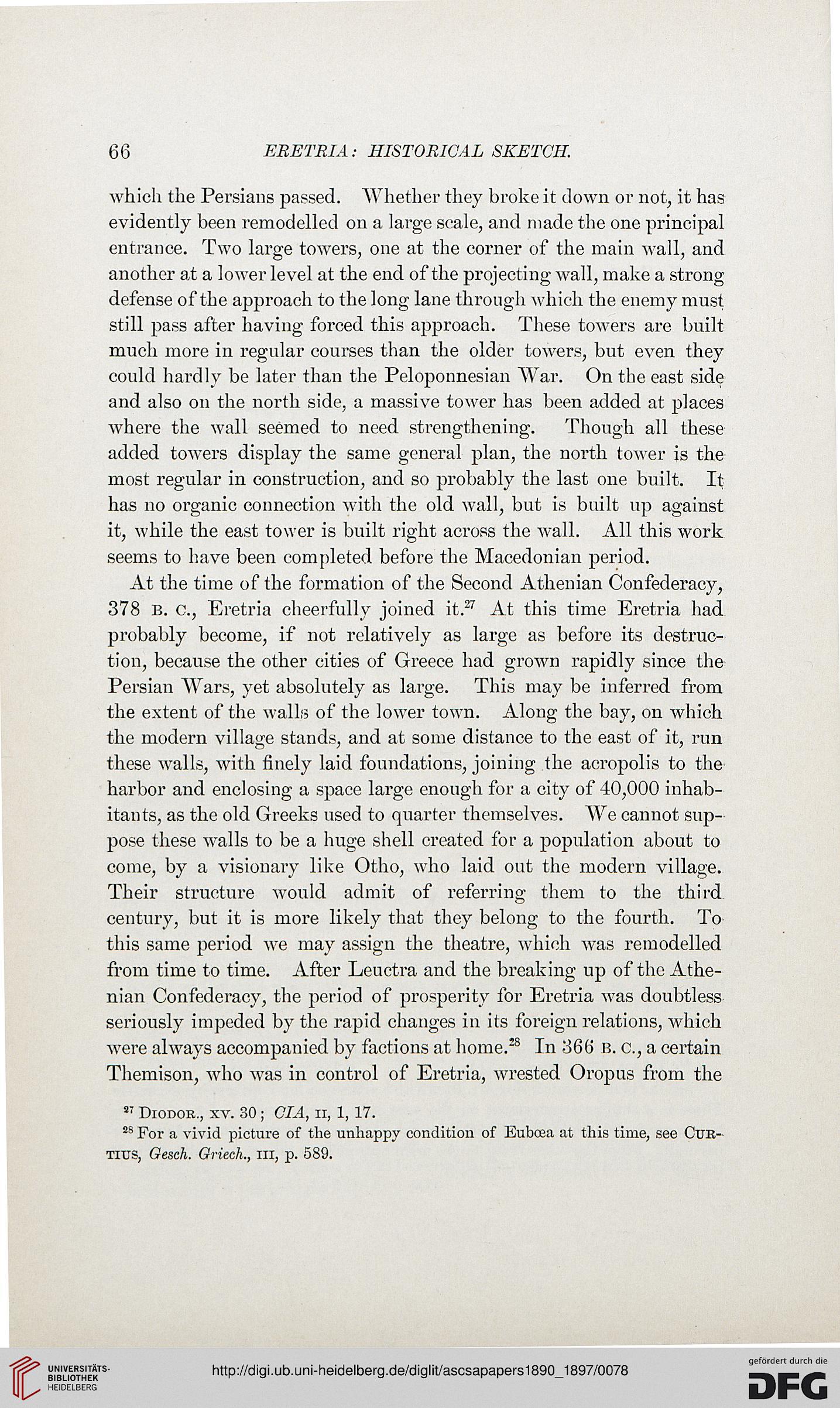66
ERETRIA: HISTORICAL SKETCH.
which the Persians passed. Whether they broke it down or not, it has
evidently been remodelled on a large scale, and made the one principal
entrance. Two large towers, one at the corner of the main wall, and
another at a lower level at the end of the projecting wall, make a strong
defense of the approach to the long lane through which the enemy must
still pass after having forced this approach. These towers are built
much more in regular courses than the older towers, but even they
could hardly be later than the Peloponnesian War. On the east side
and also on the north side, a massive tower has been added at places
where the wall seemed to need strengthening. Though all these
added towers display the same general plan, the north tower is the
most regular in construction, and so probably the last one built. It
has no organic connection with the old wall, but is built up against
it, while the east tower is built right across the wall. All this work
seems to have been completed before the Macedonian period.
At the time of the formation of the Second Athenian Confederacy,
378 B. c, Eretria cheerfully joined it.27 At this time Eretria had
probably become, if not relatively as large as before its destruc-
tion, because the other cities of Greece had grown rapidly since the
Persian Wars, yet absolutely as large. This may be inferred from
the extent of the walls of the lower town. Along the bay, on which
the modern village stands, and at some distance to the east of it, run
these walls, with finely laid foundations, joining the acropolis to the
harbor and enclosing a space large enough for a city of 40,000 inhab-
itants, as the old Greeks used to quarter themselves. We cannot sup-
pose these walls to be a huge shell created for a population about to
come, by a visionary like Otho, who laid out the modern village.
Their structure would admit of referring them to the third
century, but it is more likely that they belong to the fourth. To
this same period we may assign the theatre, which was remodelled
from time to time. After Lenctra and the breaking up of the Athe-
nian Confederacy, the period of prosperity for Eretria was doubtless
seriously impeded by the rapid changes in its foreign relations, which
were always accompanied by factions at home.28 In 366 B. c, a certain
Themison, who was in control of Eretria, wrested Oropus from the
Diodoe., xv. 30; CIA, n, 1, 17.
28 For a vivid picture of the unhappy condition of Euboea at this time, see Cub-
tius, Cesch. Oriech., m, p. 589.
ERETRIA: HISTORICAL SKETCH.
which the Persians passed. Whether they broke it down or not, it has
evidently been remodelled on a large scale, and made the one principal
entrance. Two large towers, one at the corner of the main wall, and
another at a lower level at the end of the projecting wall, make a strong
defense of the approach to the long lane through which the enemy must
still pass after having forced this approach. These towers are built
much more in regular courses than the older towers, but even they
could hardly be later than the Peloponnesian War. On the east side
and also on the north side, a massive tower has been added at places
where the wall seemed to need strengthening. Though all these
added towers display the same general plan, the north tower is the
most regular in construction, and so probably the last one built. It
has no organic connection with the old wall, but is built up against
it, while the east tower is built right across the wall. All this work
seems to have been completed before the Macedonian period.
At the time of the formation of the Second Athenian Confederacy,
378 B. c, Eretria cheerfully joined it.27 At this time Eretria had
probably become, if not relatively as large as before its destruc-
tion, because the other cities of Greece had grown rapidly since the
Persian Wars, yet absolutely as large. This may be inferred from
the extent of the walls of the lower town. Along the bay, on which
the modern village stands, and at some distance to the east of it, run
these walls, with finely laid foundations, joining the acropolis to the
harbor and enclosing a space large enough for a city of 40,000 inhab-
itants, as the old Greeks used to quarter themselves. We cannot sup-
pose these walls to be a huge shell created for a population about to
come, by a visionary like Otho, who laid out the modern village.
Their structure would admit of referring them to the third
century, but it is more likely that they belong to the fourth. To
this same period we may assign the theatre, which was remodelled
from time to time. After Lenctra and the breaking up of the Athe-
nian Confederacy, the period of prosperity for Eretria was doubtless
seriously impeded by the rapid changes in its foreign relations, which
were always accompanied by factions at home.28 In 366 B. c, a certain
Themison, who was in control of Eretria, wrested Oropus from the
Diodoe., xv. 30; CIA, n, 1, 17.
28 For a vivid picture of the unhappy condition of Euboea at this time, see Cub-
tius, Cesch. Oriech., m, p. 589.




